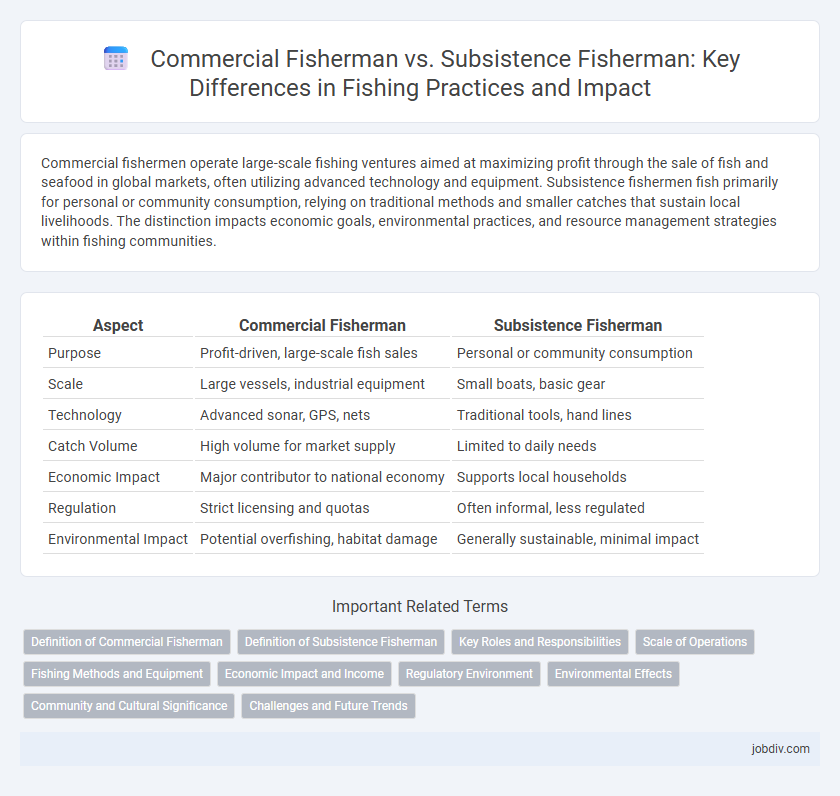Commercial fishermen operate large-scale fishing ventures aimed at maximizing profit through the sale of fish and seafood in global markets, often utilizing advanced technology and equipment. Subsistence fishermen fish primarily for personal or community consumption, relying on traditional methods and smaller catches that sustain local livelihoods. The distinction impacts economic goals, environmental practices, and resource management strategies within fishing communities.
Table of Comparison
| Aspect | Commercial Fisherman | Subsistence Fisherman |
|---|---|---|
| Purpose | Profit-driven, large-scale fish sales | Personal or community consumption |
| Scale | Large vessels, industrial equipment | Small boats, basic gear |
| Technology | Advanced sonar, GPS, nets | Traditional tools, hand lines |
| Catch Volume | High volume for market supply | Limited to daily needs |
| Economic Impact | Major contributor to national economy | Supports local households |
| Regulation | Strict licensing and quotas | Often informal, less regulated |
| Environmental Impact | Potential overfishing, habitat damage | Generally sustainable, minimal impact |
Definition of Commercial Fisherman
A commercial fisherman is an individual engaged in fishing activities primarily for economic gain, harvesting large quantities of fish or seafood to sell in markets, restaurants, or processing facilities. They utilize advanced equipment and vessels to maximize catch efficiency, often targeting specific species to meet consumer demand and regulatory quotas. This profession plays a crucial role in the global seafood supply chain, supporting both local economies and international trade.
Definition of Subsistence Fisherman
A subsistence fisherman primarily catches fish to fulfill personal or familial needs rather than for sale or profit, relying on traditional methods and local resources. This form of fishing supports daily nutrition and cultural practices within small communities, distinguishing it from commercial fishing, which targets large-scale market supply and economic gain. Subsistence fishing is critical in sustaining livelihoods in many coastal and indigenous populations worldwide.
Key Roles and Responsibilities
Commercial fishermen operate large-scale vessels targeting high-volume catches to meet market demand, focusing on species with significant economic value such as tuna, salmon, and shrimp. They ensure sustainable harvesting practices while complying with regulatory frameworks, maintaining equipment, and supporting supply chains from catch to consumer. Subsistence fishermen primarily fish to provide food for their families and communities, relying on traditional knowledge and techniques, prioritizing resource conservation and local ecosystem balance over profitability.
Scale of Operations
Commercial fishermen operate on a large scale, employing advanced vessels and technology to harvest vast quantities of fish for global markets, ensuring high-volume supply chains. Subsistence fishermen work on a much smaller scale, relying on traditional methods and small boats to catch fish primarily for personal or local community consumption. The scale of operations significantly influences their economic impact, resource management, and sustainability practices within the fishing industry.
Fishing Methods and Equipment
Commercial fishermen utilize advanced technology such as trawlers, longlines, and sonar systems to maximize catch efficiency in large-scale fishing operations. Subsistence fishermen rely on traditional methods like hand lines, nets, and small boats, focusing on sustainable harvesting for personal or community consumption. Equipment choices directly reflect the scale and purpose of fishing, with commercial practices emphasizing volume and speed, while subsistence methods prioritize resource conservation and minimal environmental impact.
Economic Impact and Income
Commercial fishermen generate significant economic impact through large-scale operations, supplying global seafood markets and supporting numerous related industries such as processing, transportation, and retail. Their income varies widely but can be substantial due to high-volume catches and access to advanced technology and markets. Subsistence fishermen primarily fish for personal and community consumption, with limited income generation, relying on traditional methods that sustain local economies but contribute minimally to broader economic systems.
Regulatory Environment
Commercial fishermen operate under strict regulatory frameworks designed to manage sustainable fish stocks, including catch limits, licensing requirements, and seasonal closures enforced by government agencies like the National Oceanic and Atmospheric Administration (NOAA). Subsistence fishermen face fewer regulations but are still subject to protections aimed at preserving traditional fishing practices and local ecosystems, often supported by tribal or community-specific rules. Differences in regulatory environments reflect the distinct objectives: commercial fishing prioritizes resource conservation and market supply, while subsistence fishing emphasizes cultural heritage and subsistence needs.
Environmental Effects
Commercial fishermen often utilize large-scale equipment and intensive fishing methods that can lead to overfishing, habitat destruction, and bycatch, significantly impacting marine ecosystems. Subsistence fishermen typically engage in small-scale, traditional practices with lower environmental footprints, promoting sustainability and ecosystem balance. The contrast in environmental effects highlights the need for regulated fishing practices to preserve aquatic biodiversity while supporting community livelihoods.
Community and Cultural Significance
Commercial fishermen drive economic development through large-scale fishing operations, supporting regional markets and export industries, while subsistence fishermen maintain cultural traditions and food security within indigenous and coastal communities. The community bond in subsistence fishing often involves generational knowledge transfer and sustainable practices deeply rooted in local customs. Both roles are vital, with commercial fishing fueling economic growth and subsistence fishing preserving cultural identity and ecological balance.
Challenges and Future Trends
Commercial fishermen face challenges such as strict regulations, overfishing, and market volatility impacting profitability, while subsistence fishermen struggle with limited access to resources and climate change affecting fish availability. Technological advancements like sustainable fishing gear and data-driven stock management are shaping the future, promoting responsible harvesting methods in commercial sectors. Community-based management and government support initiatives aim to enhance resilience for subsistence fishermen amid environmental and economic uncertainties.
Commercial Fisherman vs Subsistence Fisherman Infographic

 jobdiv.com
jobdiv.com